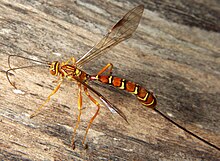Ichneumonoidea
| Ichneumonoidea Temporal range:
| |
|---|---|

| |
| Megarhyssa greenei female | |
| Scientific classification | |
| Domain: | Eukaryota |
| Kingdom: | Animalia |
| Phylum: | Arthropoda |
| Class: | Insecta |
| Order: | Hymenoptera |
| Suborder: | Apocrita |
| Superfamily: | Ichneumonoidea Latreille, 1802 |
| Families | |
| |
The superfamily Ichneumonoidea contains one extinct and three extant families, including the two largest families within
Etymology
The name is derived from Latin 'ichneumon', from Ancient Greek ἰχνεύμων (ikhneúmōn, "tracker"), from ἴχνος (íkhnos, "track, footstep").
Description
The superfamily is defined by fusion of the costal and radial veins of the fore wing, and almost all species have more than 11 antennal segments.[3] Both included families have a cosmopolitan distribution. Ichneumonoids have morphological similarities with relatives within the order Hymenoptera, including ants and bees. Ichneumonoidea contains a great deal of morphological diversity, with species ranging in size from 1 to 130 mm (0.039 to 5.118 in) long. Most are slender, and the females of many species (particularly in the genus Megarhyssa) have extremely long ovipositors for laying eggs.
The ichneumonid wasps may be more familiar to non-
Braconidae
Most are brownish or black, not brightly colored.[4] Fore wings lack vein 2m-cu.
Ichneumonidae
Ichneumonids vary greatly in size and their color varies from brightly colored to uniform black. Fore wing with vein 2m-cu present and tubular.[3]
Evolution
Parasitoidism evolved only once in the Hymenoptera during the Permian, leading to a single clade which contains the Apocrita and the Orussoidea, but has been secondarily lost multiple times. The Apocrita emerged from that clade during the Jurassic.[5][6][7][8]
| Hymenoptera |
| ||||||||||||||||||||||||
Parasitic life cycle
Ichneumonoids are solitary insects, and the vast majority are
The female ichneumonoid finds a host and lays an egg on, near, or inside the host's body.[9] The ovipositor of ichneumonoids generally cannot deliver a sting as many wasps or bees do. It can be used to bore wood and lay eggs on hosts deep inside, or reach hosts hidden inside leaf shelters. Upon hatching, the larva feeds either externally or internally, killing the host when it is ready to pupate.
Various ichneumonoids are used as
- Life cycle of Hercus fontinalis
-
Early instar larvae on caterpillar
-
Later instar larvae
-
Final instar larvae building cocoon
-
Pupa inside cocoon
-
Adults emerging from cocoons
-
Adult female
References
- PMID 16332211.
- ^ "Strong's Greek: 2487. ἴχνος (ichnos) -- a track". biblehub.com.
- ^ a b H., Goulet; J.T., Huber (1993). "10: Superfamily Ichneumonoidea". Hymenoptera of the world: An identification guide to families.
- ^ Borror and White
- PMID 28376325.

- ^ Schulmeister, S. "Symphyta". Archived from the original on 21 June 2010. Retrieved 28 November 2016.
- PMID 28343967.
- ^ Sezen, Uzay. "Two ichneumon wasps competing to oviposit". Retrieved 12 September 2011.
- ^ .
External links
 Data related to Ichneumonoidea at Wikispecies
Data related to Ichneumonoidea at Wikispecies Media related to Ichneumonoidea at Wikimedia Commons
Media related to Ichneumonoidea at Wikimedia Commons- Reference large-format photos of 15 different species of Ichneumonidae
- An interesting account of an observer's encounter with Ichneumons.
- University of Florida Department of Entomology & Nematology page about ichneumons
- Bugguide.net. Superfamily Ichneumonoidea - Braconids and Ichneumons








